SKODA SUPERB 2007 1.G / (B5/3U) Owner's Manual
Manufacturer: SKODA, Model Year: 2007, Model line: SUPERB, Model: SKODA SUPERB 2007 1.G / (B5/3U)Pages: 259, PDF Size: 14.71 MB
Page 211 of 259

Breakdown assistance
210
WARNING
•If you find yourself in flowing traffic switch on the hazard warning lights
system and place the warning triangle on the side of the road at the
prescribed distance from your vehicl e while observing all national legal
provisions. In this way you are protecting not only yourself but also other
road users.
•Never start the engine with the vehicle sitting on the raised jack - danger
of suffering injury!
Caution
If you have to change a wheel on a slope first block the opposite wheel with a stone
or similar object in order to secure th e vehicle from unexpectedly rolling away.
Note
Comply with the national legal regulations.
Changing a wheel
Always change a wheel on a level surface as far as possible.
– Take off the full wheel trim* ⇒page 211 or the caps ⇒page 211.
– In the case of light alloy wheels remove the wheel trim cap ⇒page 211.
– Slacken the wheel bolts ⇒page 212.
– Jack up the vehicle until the wheel to be changed is clear of the ground
⇒ page 213.
– Unscrew the wheel bolts and place them on a clean surface (cloth, paper etc.).
– Take off the wheel. – Fit on the spare wheel and tighten the wheel bolts slightly.
– Lower the car.
– Tighten the wheel bolts firmly, al
ternately and diagonally using the
wheel wrench ⇒page 212.
– Mount the full wheel trim/w heel trim cap or the caps.
Note
•All bolts must be clean and must turn easily.
•You must never grease or oil the wheel bolts!
•When fitting on unidirectional tyres, ensure that the tyres rotate in the correct
direction ⇒page 199.
Subsequent steps
After changing the wheel, you must perform the following steps.
– Stow and attach the replaced wheel in the spare wheel well.
– Stow the vehicle tool kit in the space provided.
– Check the tyre pressure on the spare wheel just mounted as soon as
possible.
– Have the tightening torque of the wheel bolts checked with a torque
wrench as soon as possible. The tightening torque for steel and light
alloy wheels must be 120 Nm.
– Have the defective tyre repaired as soon as possible.
WARNING
It is necessary to observe the guidelines given on ⇒page 201, “New tyres
and wheels” if the vehicle is subseq uently fitted with tyres which are
different to those it was fitted with at the works.
NKO B5 20.book Page 210 Friday, March 2, 2007 1:46 PM
Page 212 of 259

Breakdown assistance211
Using the systemSafetyDriving TipsGeneral MaintenanceBreakdown assistanceTechnical Data
Note
•If you find, when changing the wheel, that the wheel bolts are corroded and
difficult to turn, the bolts mu st be replaced before checking the tightening torque.
•Drive cautiously and only at a moderate speed to a workshop where the tight-
ening torque can be checked.
Full wheel trim*
Pulling off
– Hook the clamp (found in the vehicle toolkit) into the reinforced edge of the full wheel trim.
– Push the wheel key through the clamp, support the wheel key at the tyre and pull off the wheel trim.
Installing
– First press the full wheel trim onto the wheel at the valve opening provided. Then press the full wheel trim into the wheel in such a way
that its entire circumference locks correctly in place.
Caution
•Use the pressure of your hand, do not knock on the full wheel trim! Heavy
knocks mainly on the points where the full wheel trim has not been inserted into
the wheel, can result in damage to the guide and centering elements of the full
wheel trim.
•First check for yourself that the th eft-deterrent wheel bolt is located
⇒ page 214, “Securing wheels against being stolen” in the hole in the area of the
valve before fitting the full wheel trim onto a steel wheel which is attached with a
theft-deterrent wheel bolt.
Wheel trim caps*
Pulling off
– Carefully ⇒fig. 192 lever off the wheel trim cap using the removal
hook .
Wheel bolts with caps*
The caps are designed to protect the wheel bolts.
B1Z-0042HB1Z-0042H
Fig. 192 Changing a
wheel: Pulling off the
wheel trim cap
B1Z-0042HB1Z-0042HFig. 193 Changing a
wheel: Removing the cap
NKO B5 20.book Page 211 Friday, March 2, 2007 1:46 PM
Page 213 of 259

Breakdown assistance
212
Pulling off
– Insert the plastic clip (in the car tool kit) sufficiently far onto the cap
until the inner catches of the clip are positioned at the collar of the
cap.
– Pull the cap off with the plastic clip ⇒ page 211, fig. 193 .
Installing
– Insert the caps onto the bolts.
Slackening and tightening wheel bolts
Slacken the wheel bolts before jacking up the vehicle.
Slackening wheel bolts
– Insert the wheel wrench fully onto the wheel bolt
5).
– Grasp the end of the wrench and turn the bolt about one turn to the left ⇒fig. 194 . Tightening wheel bolts
– Insert the wheel wrench fully onto the wheel bolt
5).
– Grasp the end of the wrench and turn the bolt to the right until it is tight.
WARNING
Slacken the wheel bolts only a little (about one turn) as long as the vehicle
has not yet been jacked up - risk of an accident!.
Note
•Do not use the hexagon socket in the ha ndle of the screwdriver for slackening
or tightening the wheel bolts.
•apply pressure carefully with your foot to the end of the wheel wrench if it
proves difficult to slacken the wheel bolts. Hold tight on the vehicle when doing this
and ensure that you have a steady position.
5)Use the appropriate adapter for slackening and tightening the safety wheel bolts
⇒ page 214.
Fig. 194 Changing a
wheel: Slackening wheel
bolts
NKO B5 20.book Page 212 Friday, March 2, 2007 1:46 PM
Page 214 of 259
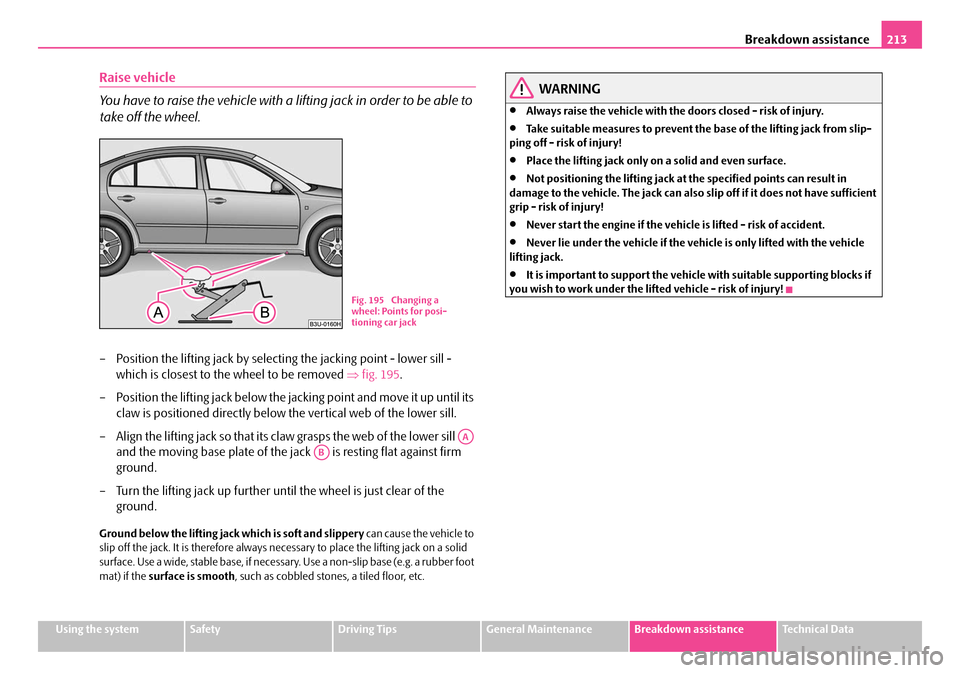
Breakdown assistance213
Using the systemSafetyDriving TipsGeneral MaintenanceBreakdown assistanceTechnical Data
Raise vehicle
You have to raise the vehicle with a lifting jack in order to be able to
take off the wheel.
– Position the lifting jack by selecting the jacking point - lower sill -
which is closest to the wheel to be removed ⇒fig. 195 .
– Position the lifting jack below the jacking point and move it up until its claw is positioned directly below the vertical web of the lower sill.
– Align the lifting jack so that its claw grasps the web of the lower sill and the moving base plate of the ja ck is resting flat against firm
ground.
– Turn the lifting jack up further until the wheel is just clear of the ground.
Ground below the lifting jack which is soft and slippery can cause the vehicle to
slip off the jack. It is therefore always ne cessary to place the lifting jack on a solid
surface. Use a wide, stable base, if necessary. Use a non-slip base (e.g. a rubber foot
mat) if the surface is smooth , such as cobbled stones, a tiled floor, etc.
WARNING
•Always raise the vehicle with the doors closed - risk of injury.
•Take suitable measures to prevent the base of the lifting jack from slip-
ping off - risk of injury!
•Place the lifting ja ck only on a solid and even surface.
•Not positioning the lifting jack at the specified points can result in
damage to the vehicle. The jack can also sl ip off if it does not have sufficient
grip - risk of injury!
•Never start the engine if the vehicl e is lifted - risk of accident.
•Never lie under the vehicle if the vehicle is only lifted with the vehicle
lifting jack.
•It is important to support the vehicle with suitable supporting blocks if
you wish to work under the lifted vehicle - risk of injury!
Fig. 195 Changing a
wheel: Points for posi-
tioning car jack
AA
AB
NKO B5 20.book Page 213 Friday, March 2, 2007 1:46 PM
Page 215 of 259

Breakdown assistance
214
Taking off and fitting on wheel
After you have slackened the wheel bolts and have raised the car with the
car jack, replace the wheel as follows:
Changing a wheel
– Turn the wheel bolt which is farthest to the top fully out with the
hexagon socket in the screwdriver handle (car tool kit) and place the
bolt down on a clean surface ⇒fig. 196 .
– Screw the assembly pin (car t ool kit) into the vacant hole ⇒fig. 197 .
– Unscrew the remaining wheel bolts as described above. – Take off the wheel.
Fitting on wheel
– Push the spare wheel over the assembly pin.
– Screw in the wheel bolts and tighten them
slightly with the aid of the
hexagon socket.
– Unscrew the assembly pin and screw in the remaining wheel bolt also slightly.
The wheel bolts must be clean and must turn easily.
The hexagon socket in the handle of the sc rewdriver makes it simpler to fit on the
wheel bolts. The reversible blade should be pulled out for this step.
When fitting on unidirectional tyres, ensure that the tyres rotate in the correct
direction ⇒page 204.
Note
Do not use the hexagon socket in the hand le of the screwdriver for slackening or
tightening the wheel bolts.
Securing wheels against being stolen
You need a special adapter for slackening the safety wheel bolts.
B1Z-0042HB1Z-0042H
Fig. 196 Changing a
wheel: Remove bolts
with hexagon in screw-
driver
B1Z-0042HB1Z-0042HFig. 197 Changing a
wheel: assembly pin
Fig. 198 Safety wheel
bolt with adapter
NKO B5 20.book Page 214 Friday, March 2, 2007 1:46 PM
Page 216 of 259
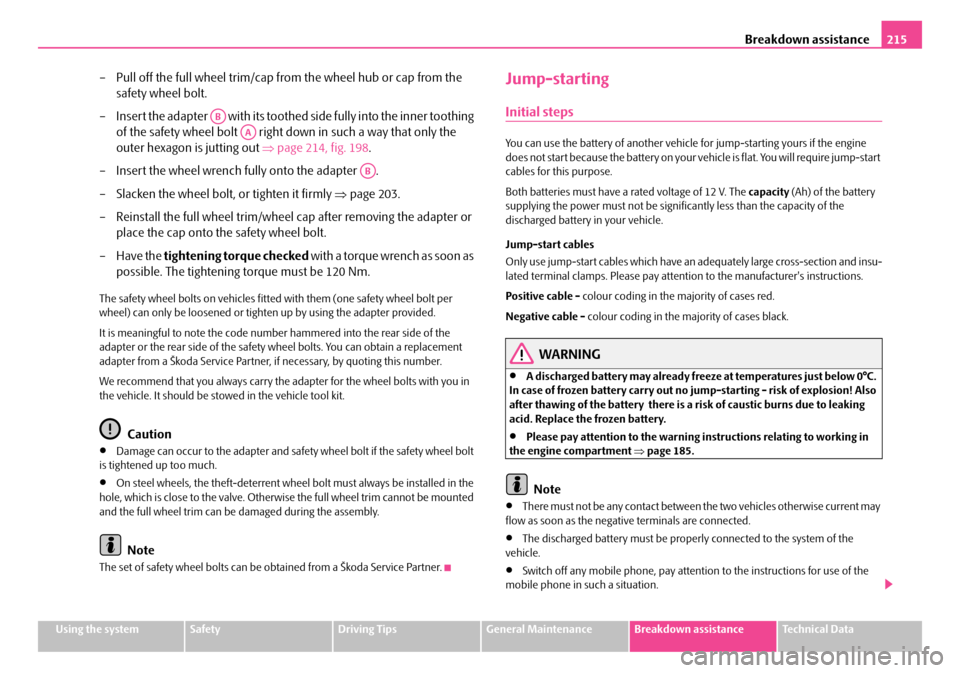
Breakdown assistance215
Using the systemSafetyDriving TipsGeneral MaintenanceBreakdown assistanceTechnical Data
– Pull off the full wheel trim/cap from the wheel hub or cap from the
safety wheel bolt.
– Insert the adapter with its toothed side fully into the inner toothing of the safety wheel bolt right do wn in such a way that only the
outer hexagon is jutting out ⇒page 214, fig. 198 .
– Insert the wheel wrench fully onto the adapter .
– Slacken the wheel bolt, or tighten it firmly ⇒page 203.
– Reinstall the full wheel trim/wheel cap after removing the adapter or place the cap onto the safety wheel bolt.
–Have the tightening torque checked w i t h a t o rq u e w re n c h a s s o o n a s
possible. The tightening torque must be 120 Nm.
The safety wheel bolts on vehicles fitted with them (one safety wheel bolt per
wheel) can only be loosened or tighten up by using the adapter provided.
It is meaningful to note the code numb er hammered into the rear side of the
adapter or the rear side of the safety wheel bolts. You can obtain a replacement
adapter from a Škoda Service Partner, if necessary, by quoting this number.
We recommend that you alwa ys carry the adapter for the wheel bolts with you in
the vehicle. It should be st owed in the vehicle tool kit.
Caution
•Damage can occur to the adapter and safety wheel bolt if the safety wheel bolt
is tightened up too much.
•On steel wheels, the theft-deterrent wheel bolt must always be installed in the
hole, which is close to the valve. Otherwise the full wheel trim cannot be mounted
and the full wheel trim can be damaged during the assembly.
Note
The set of safety wheel bolts can be obtained from a Škoda Service Partner.
Jump-starting
Initial steps
You can use the battery of another vehicl e for jump-starting yours if the engine
does not start because the battery on your vehicle is flat. You will require jump-start
cables for this purpose.
Both batteries must have a rated voltage of 12 V. The capacity (Ah) of the battery
supplying the power must not be signif icantly less than the capacity of the
discharged battery in your vehicle.
Jump-start cables
Only use jump-start cables which have an adequately large cross-section and insu-
lated terminal clamps. Please pay attention to the manufacturer's instructions.
Positive cable - colour coding in the majority of cases red.
Negative cable - colour coding in the majority of cases black.
WARNING
•A discharged battery may already freez e at temperatures just below 0°C.
In case of frozen battery carry out no jump-starting - risk of explosion! Also
after thawing of the battery there is a risk of caustic burns due to leaking
acid. Replace the frozen battery.
•Please pay attention to the warning instructions relating to working in
the engine compartment ⇒page 185.
Note
•There must not be any contact between the two vehicles otherwise current may
flow as soon as the negative terminals are connected.
•The discharged battery must be proper ly connected to the system of the
vehicle.
•Switch off any mobile phone, pay attent ion to the instructions for use of the
mobile phone in such a situation.
AB
AA
AB
NKO B5 20.book Page 215 Friday, March 2, 2007 1:46 PM
Page 217 of 259
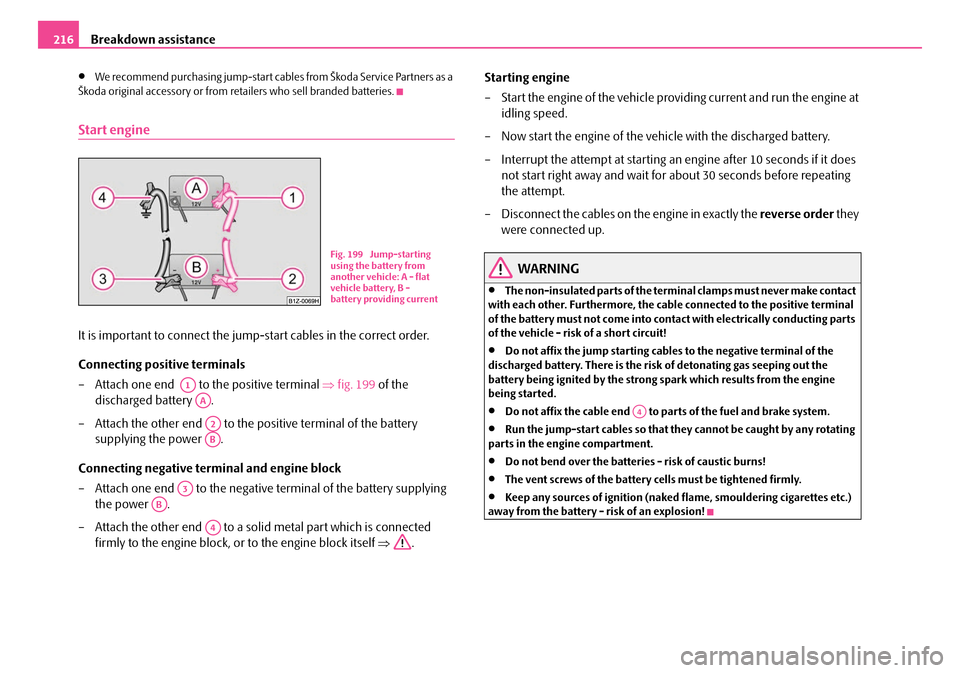
Breakdown assistance
216
•We recommend purchasing jump-start cabl es from Škoda Service Partners as a
Škoda original accessory or from retailers who sell branded batteries.
Start engine
It is important to connect the jump-start cables in the correct order.
Connecting positive terminals
– Attach one end to the positive terminal ⇒fig. 199 of the
discharged battery .
– Attach the other end to the positive terminal of the battery supplying the power .
Connecting negative term inal and engine block
– Attach one end to the negative terminal of the battery supplying
the power .
– Attach the other end to a soli d metal part which is connected
firmly to the engine block, or to the engine block itself ⇒. Starting engine
– Start the engine of the vehicle prov
iding current and run the engine at
idling speed.
– Now start the engine of the vehicle with the discharged battery.
– Interrupt the attempt at starting an engine after 10 seconds if it does
not start right away and wait for about 30 seconds before repeating
the attempt.
– Disconnect the cables on the engine in exactly the reverse order they
were connected up.
WARNING
•The non-insulated parts of the terminal clamps must never make contact
with each other. Furthermore, the cabl e connected to the positive terminal
of the battery must not come into contact with electrically conducting parts
of the vehicle - risk of a short circuit!
•Do not affix the jump starting cables to the negative terminal of the
discharged battery. There is the risk of detonating gas seeping out the
battery being ignited by the strong spark which results from the engine
being started.
•Do not affix the cable end to pa rts of the fuel and brake system.
•Run the jump-start cables so that they cannot be caught by any rotating
parts in the engine compartment.
•Do not bend over the batteries - risk of caustic burns!
•The vent screws of the battery cells must be tightened firmly.
•Keep any sources of ignition (naked flame, smouldering cigarettes etc.)
away from the battery - risk of an explosion!
Fig. 199 Jump-starting
using the battery from
another vehicle: A - flat
vehicle battery, B -
battery providing current
A1
AA
A2
AB
A3
AB
A4
A4
NKO B5 20.book Page 216 Friday, March 2, 2007 1:46 PM
Page 218 of 259
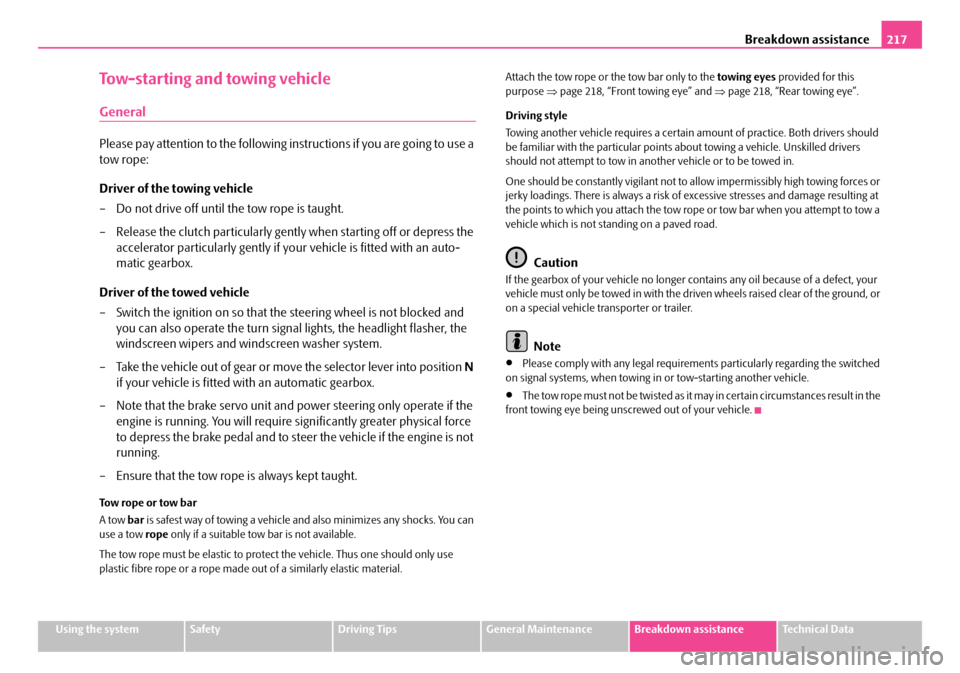
Breakdown assistance217
Using the systemSafetyDriving TipsGeneral MaintenanceBreakdown assistanceTechnical Data
Tow-starting and towing vehicle
General
Please pay attention to the following in structions if you are going to use a
tow rope:
Driver of the towing vehicle
– Do not drive off until the tow rope is taught.
– Release the clutch particularly gent ly when starting off or depress the
accelerator particularly gently if yo ur vehicle is fitted with an auto-
matic gearbox.
Driver of the towed vehicle
– Switch the ignition on so that the steering wheel is not blocked and you can also operate the turn signal lights, the headlight flasher, the
windscreen wipers and windscreen washer system.
– Take the vehicle out of gear or move the selector lever into position N
if your vehicle is fitted with an automatic gearbox.
– Note that the brake servo unit and power steering only operate if the engine is running. You will require si gnificantly greater physical force
to depress the brake pedal and to steer the vehicle if the engine is not
running.
– Ensure that the tow rope is always kept taught.
Tow rope or tow bar
A tow bar is safest way of towing a vehicle and also minimizes any shocks. You can
use a tow rope only if a suitable to w bar is not available.
The tow rope must be elastic to protect the vehicle. Thus one should only use
plastic fibre rope or a rope made out of a similarly elastic material. Attach the tow rope or the tow bar only to the
towing eyes provided for this
purpose ⇒page 218, “Front towing eye” and ⇒page 218, “Rear towing eye”.
Driving style
Towing another vehicle requires a certain amount of practice. Both drivers should
be familiar with the partic ular points about towing a vehicle. Unskilled drivers
should not attempt to tow in another vehicle or to be towed in.
One should be constantly vigi lant not to allow impermissibly high towing forces or
jerky loadings. There is always a risk of excessive stresses and damage resulting at
the points to which you attach the tow rope or tow bar when you attempt to tow a
vehicle which is not stan ding on a paved road.
Caution
If the gearbox of your vehicle no longer contains any oil because of a defect, your
vehicle must only be towed in with the driven wheels raised clear of the ground, or
on a special vehicle transporter or trailer.
Note
•Please comply with any legal requiremen ts particularly regarding the switched
on signal systems, when towing in or tow-starting another vehicle.
•The tow rope must not be twisted as it may in certain circumstances result in the
front towing eye being unscrewed out of your vehicle.
NKO B5 20.book Page 217 Friday, March 2, 2007 1:46 PM
Page 219 of 259
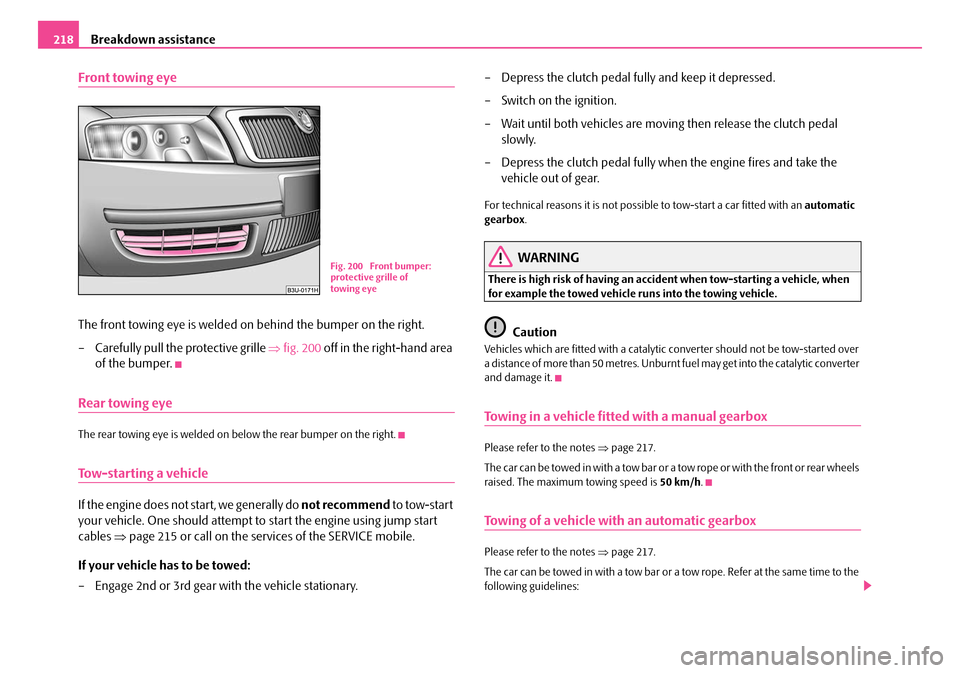
Breakdown assistance
218
Front towing eye
The front towing eye is welded on behind the bumper on the right.
– Carefully pull the protective grille ⇒fig. 200 off in the right-hand area
of the bumper.
Rear towing eye
The rear towing eye is welded on below the rear bumper on the right.
Tow-starting a vehicle
If the engine does not start, we generally do not recommend to tow-start
your vehicle. One should attempt to start the engine using jump start
cables ⇒page 215 or call on the servic es of the SERVICE mobile.
If your vehicle has to be towed:
– Engage 2nd or 3rd gear wi th the vehicle stationary. – Depress the clutch pedal fully and keep it depressed.
– Switch on the ignition.
– Wait until both vehicles are movi
ng then release the clutch pedal
slowly.
– Depress the clutch pedal fully when the engine fires and take the vehicle out of gear.
For technical reasons it is not possib le to tow-start a car fitted with an automatic
gearbox .
WARNING
There is high risk of having an accident when tow-starting a vehicle, when
for example the towed vehicle runs into the towing vehicle.
Caution
Vehicles which are fitted with a catalytic converter should not be tow-started over
a d i s t a n c e o f m o re t h a n 5 0 m e t re s . U n b u r n t fuel may get into the catalytic converter
and damage it.
Towing in a vehicle fitted with a manual gearbox
Please refer to the notes ⇒ page 217.
The car can be towed in with a tow bar or a tow rope or with the front or rear wheels
raised. The maximum towing speed is 50 km/h.
Towing of a vehicle with an automatic gearbox
Please refer to the notes ⇒ page 217.
The car can be towed in with a tow bar or a tow rope. Refer at the same time to the
following guidelines:
Fig. 200 Front bumper:
protective grille of
towing eye
NKO B5 20.book Page 218 Friday, March 2, 2007 1:46 PM
Page 220 of 259

Breakdown assistance219
Using the systemSafetyDriving TipsGeneral MaintenanceBreakdown assistanceTechnical Data
•Move selector lever into N .
•The maximum towing speed is 50 km/h.
•The maximum permissible towing distance is 50 km. The gear oil pump does
not operate when the engine is not running and the gear would not be adequately
lubricated at higher speeds an d over longer towing distance.
Caution
If the vehicle is towed in by a recovery vehi cle, it should only be towed in with the
front wheels raised. If the vehicle is raised at rear, the automatic gearbox is
damaged!
Note
The vehicle must be transported on a special ve hicle or trailer if it is not possible to
tow in the vehicle in the way described or if the towing distance is greater than
50 km.
NKO B5 20.book Page 219 Friday, March 2, 2007 1:46 PM